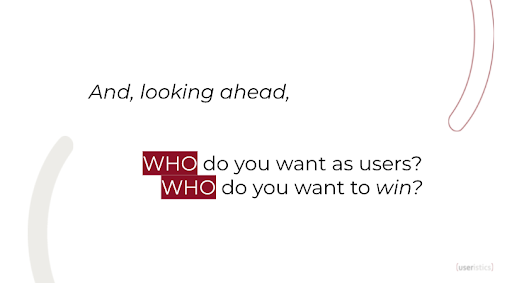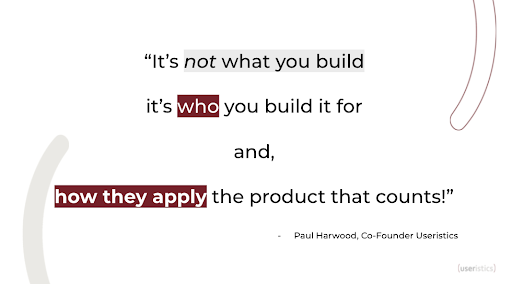Who Are Your Users? Like, Really.
Tina Nayak

Woohoo! Our first cohort of Useristics #UC01 launched on August 23, 2021 and when a room is full of Tech Startup Founders, Product Management, Design & Community Leaders, you can imagine the energy and the discussion. What an honor!
These blog posts are intended to help you with the key concepts of user understanding so you too build a user-centric product.
When you’re creating something new for the world, an entirely new product, a solution to a problem, building a user-centric experience is key to success.
In the first session we covered the following topics:
1. Why does user understanding matter
a. Your product should provide utility
b. Users change constantly
c. As you grow your, your users evolve and change
2. The key terms - Who are your users, customers, non-users?
a. Explaining the terms
b. Why it matters to identify or define them
c. How this impacts your product and business strategy
3. How does understanding users fit in?
4. Why is it important?
Point is, your users are important. And they are different for every market you want to launch in.
If you want to win in each market that you launch in, then you need to understand who your users are.
In this post we focus on the key foundational topics you must focus on as you launch new features, enter new markets or add new segments.
By the end of this post you will have a simple yet powerful framework on what you should be thinking to build a product that the market needs.
Let’s go.
First, meet Paul. These sessions are led by Paul as he brought his experience and deep expertise in markets like Americas, LATAM, EMEA, ASIA and MENA
About Paul Harwood
Paul is a Ph.D and an expert in international market and user research. Today he conducts research for numerous brand-name tech companies, both large and small.
From pre-seed start-ups to some of today’s most celebrated international unicorns, Paul brings over 20 years of research and teaching experience to Useristics. He combines the rigor of academia with hands-on in-market commercial experience, as prior to his roles as Market Research Lead at Twitter and User Sentiment researcher at Facebook.
Paul was an Associate Professor, and a Research Fellow at the Pew Internet and American Life Project.
During the session, Paul asked a very intriguing question to the class.

Why is this important?
It’s important because if you want to win, you need to get clarity on who you are building for.
This brings a razor sharp focus not just for the start-up founders but also for the entire team so they can build and scale efficiently.
In other words, this clarity nurtures a team culture that’s always user-centric.
So, Why Does User Understanding Matter?
At Useristics, we see two main reasons why understanding users matter:
1. Your product must provide utility to your user
1. Your product must provide utility to your user
Understanding users matter because you need to build a product that provides utility for your users.
You can make the best product with the best features, meticulously crafting how your user might or should use the product and adding the finer touches, but the hard truth is that it doesn’t matter how you think they could/would/should use the product.
What’s actually going to matter is how your user actually applies your product.

2. Your users evolve and change as your business grows
Your users will continually evolve as your business grows.
Take Facebook for example.
The early adopters and users of Facebook were young college students. If you look at Facebook today, its users are primarily parents and grandparents.
What’s particularly interesting is that both these sets of users apply the same product in very different ways and for different reasons.
If Facebook in the 2000s, would’ve become complacent and said, ‘Hey, we know who our users are and we’re done, things would look very different for them now.
If we think more deeply, we know and see all around us that behaviors are evolving and changing continuously.
Why?
Because of the dynamic nature of the technology landscape and the number of tools coming to market, your users have more choices, better solutions to their problems, and newer, cheaper, faster ones at their fingertips.
"When you invest in a cadence to understand your users, you are investing in building leverage for your startup"
This builds deep trust with your end users which means better value and hopefully longer lifetimes
I hope this illustrates why user understanding and not research outsourced to a person or a department or an agency can become a proxy to – ‘We are user centric’.
It’s the education and the understanding that will drive competitive advantage, leverage, and set you to win in the markets you choose to get in.
If you are playing to win, here’s the secret sauce:
“Invest time in continuously understanding your users.”
Afterall, the users for whom you are building are the reason why you exist in the first place.
So the next question is, who are your users? Like really?
This is THE question a startup needs to answer first.
Come to think of it, everything else you do is secondary.
When I ask this question to startups that I mentor and coach, the majority of them give a decent answer. But, as I probe further, this starts to crumble, and then hesitation and doubt start surfacing to the top.
If you are a founder or a startup leader, I urge you to take a moment and think about these questions:
>> Who are your products’ users?
>> Who are their customers?
>> Are they both the same?
Let’s unpack this a bit.
To illustrate that, here’s a hypothetical example. Let’s look at a few students who applied to the Useristics cohort and understand our users a bit more in detail.
Scenario 1:
Anna is our cohort student, a founder of a startup she just co-founded. She paid for this course through her credit card and is attending the two 90 mins weekly live sessions. She engages well, asks questions in the sessions. She also takes a lot of notes, uses her colorful markers in her notebook and also documents her learnings in Notion study space.
Once the session is over, she further blocks additional time in her calendar over the weekend to read through her notes, and ways on how she can apply what she’s learning in her startup.
Scenario 2:
Hector is also our cohort student. He is an ambitious Product Leader in a fast growing technology startup that just received funding. He wants to understand how he can build a culture of integrating the user’s voice in the product development process. So he reaches out to his manager if this cohort fees can be compensated. His manager loves his initiative, attitude, drive and ambition, thus approving the request.
Hector is the only one who attends this cohort from this startup.
Scenario 3:
Maya: Works as a designer in another fast growing big data AI early stage startup. The startup’s founder John nominated her to come along with him for this cohort.
Maya and John attend the cohort along with Anna and Hector.
Now, if you look at these 4 students, which of these 4 would you say are ‘a user’ and ‘a customer’? Are they both the same?
While you think about that, here’s a fun fact for you…
Fun Fact:
‘Customer insights’ has an average of 12,100 monthly searches whereas ‘User insights’ has only 1,900 average monthly searches in comparison.
What I understand from this data point is that:
>> Customer as a term is more attractive to businesses as it cues revenue and monetization.
In most cases, customer and users are used interchangeably.
In our cohort , we dived deeper with our cohort participants to understand and think of them carefully from day one on. Users and customers may be the same person sometimes, but in many cases they are not.
Here are the answers:
| Scenario #01 | Anna | User & Customer |
| Scenario #02 | Hector (Hector's Manager) |
User User & Customer |
| Scenario #03 | Maya John (Maya's Manager) |
User User & Customer |
Why are users and customers different?
Because the purchase decision rests with the customer and when the user and customer are both different, we must take the extra time to really understand both in greater detail.
This is just one of the many aspects of users and customers. To take this a step further, when you look at engagement and retention, the frequency in which a user might touch your product will differ. A customer will interact at payment vs a user using the product more often.
It’s these nuances, that not only add a layer of richness in understanding but also over time will bring so much clarity when you are building your product strategy and roadmap because they are all firmly rooted and will lead to high quality product and business decisions.
If you are looking at the early stages of growth and are focusing on adoption, like the startups in our inaugural cohort, it’s even more critical that you understand the differences between them and also the non- users. What are their adoption drivers, their needs and also their unmet needs.
In conclusion
When you understand your users, you give yourself, your team, your stakeholders and your business a fair chance to win!
Understanding your users is a systematic and a scientific approach. It’s a recipe that combines the art of understanding and the science of numbers.
Our cohorts are an endeavor to get this knowledge out there, share what we know and then help and coach the startup teams in the cohort, apply and troubleshoot with them. You don’t have to do it alone.
It’s just that the vast majority of the startups and their teams don’t know what they don’t know.
If this interests you, I invite you to sign up for our fortnightly newsletter or subscribe to our blog as we unpack learnings from our cohort, and bring you in on the lessons, major takeaways that will help you too.

We are a behavioral science international market and UX research consulting company. We empower ambitious, growth-oriented businesses to better understand their customers and users, in order to build products and experiences they can’t live without. We empower businesses to build and brand better.
Useristics, Inc.
Four Embarcadero Center,
Suite 1400
San Francisco, CA 94111
USA
Copyright © 2024

